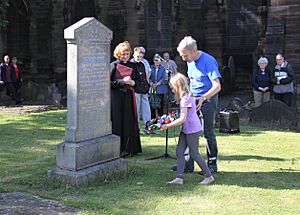- This page was last modified on 17 October 2025, at 10:18. Suggest an edit.
Church of SS Peter & Paul, Aston facts for kids
| St Peter & Paul, Aston juxta Birmingham | |
|---|---|
 |
|
| 52°30′25″N 1°52′47″W / 52.5070°N 1.8797°W | |
| Denomination | Church of England |
| Churchmanship | Evangelical |
| Website | www.astonnechellscofe.org.uk |
| History | |
| Dedication | St Peter & St Paul |
| Specifications | |
| Height | 198 feet (60 m) |
| Administration | |
| Parish | Aston and Nechells |
| Diocese | Birmingham |
| Province | Canterbury |
The Parish Church of St Peter and St Paul is a historic church located in Aston, Birmingham, England. It's a parish church part of the Church of England, dedicated to two important saints, St Peter and St Paul. This church is a significant landmark in Aston, standing tall near famous places like Villa Park.
Contents
Aston's History and the Church
The story of Aston and its church goes back a long time. Digs in 2013 found signs of a British Roman settlement in the area. In 1086, a survey called the Domesday Book showed Aston was much more valuable than nearby Birmingham.
Aston Hall, a famous mansion, was built in 1618. For a long time, Aston was a rich farming area. Later, Birmingham grew with factories, and Aston became a busy place with homes and industries. The area changed a lot over the years, especially with new roads and changes in industry.
Today, the church is in the Aston Hall and Church Conservation Area. It stands between a major motorway and Villa Park, the home stadium of Aston Villa Football Club. The church building is very important, listed as Grade II* for its special history and architecture.
The Church's Long History
The church was likely first built around the 800s, when Aston was part of the Kingdom of Mercia. The very first church was probably made of wood. This early church was mentioned in the Domesday Book.
Aston's church parish was huge, covering a very large area. It had smaller churches, called chapels of ease, in places like Yardley and Castle Bromwich. It's thought that St Peter and St Paul was a "minster church," meaning it was a main church that served many smaller areas.
The first stone church was finished in 1120. It was the second largest church in the West Midlands at that time. The church was updated in 1480. The tall tower and spire you see today are from this time, though the spire was repaired in the late 1700s.
Another big change happened in 1879. A famous architect named J. A. Chatwin worked on it. More recently, in 2008, a special stone platform was added inside the church. It has a unique cross-shaped pool for baptisms.
Amazing Memorials and Windows
This church is home to many beautiful and important memorials, some dating back to 1360.
- Shakespeare's Family: You can find three tombs for the Arden family, who were ancestors of the famous writer William Shakespeare. There's even a special window dedicated to Shakespeare.
- Wars of the Roses: Two tombs are linked to the Wars of the Roses, a series of battles in England. One shows William Harcourt, a knight from 1483, wearing English armor. Another beautiful memorial is for Sir Thomas de Erdington (died 1449), who gave his name to the Erdington area of Birmingham.
- John Rogers: There's a bust from the 1800s for John Rogers. He was born in Aston in 1500 and was a very important person. He created the Matthew Bible, which was the first full English translation of the Bible directly from Greek. He was sadly executed in 1555 for his work.
- Charlene Ellis and Letisha Shakespeare: A mosaic memorial was put in place in 2019. It remembers Charlene Ellis (18) and Letisha Shakespeare (17), who were tragically killed in 2003. Their mothers started a campaign against gun and knife crime, which continues today. The community helped create this mosaic.
- Joseph Ansell: The church has a brass eagle lectern, which is a memorial to Joseph Ansell. He started Ansells Brewery and was a church leader from 1867 to 1883.
The church also has some amazing stained-glass windows from the Victorian era. One recently repaired window shows four scenes from the story of Christmas.
The Church Organ
The church has a large pipe organ with three keyboards. The first organ was in the church tower. The current organ was built in 1901 and is located near the front of the church. It was updated in 1967 with electric parts and more sounds.
Organists of the Church
- Thomas F. Thomason, around 1912
The Churchyard
The churchyard, the area around the church, is no longer used for burials. The city council is now in charge of looking after it. Some parts were cleared in the 1950s to honor a former vicar, Rt Rev Henry McGowen.
Here are some important memorials you can find in the churchyard:
- 31 memorials for soldiers who died in wars.
- A memorial for Alfred Wilcox VC, a brave soldier.
- The family tomb of the Ansell family, who were important in the area.
- A memorial for Henry Johnson (1809–1890), put there by bell ringers from all over England. He helped create the Central Council of Church Bellringers.
- The Aston War Memorial, which was dedicated in 1921 as a peace memorial. It's also a listed structure.

This old painting from 1775 shows that Aston Hall and the church used to be surrounded by open countryside.
External links
- Aston WW1 Memorial Project

